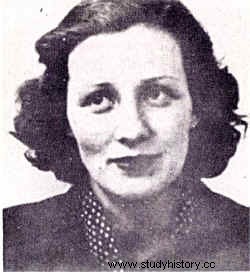Marie-Madeleine Bridou who became Fourcade through marriage (1909 – 1989) is one of the only women to have been at the head of a resistance network in France, one of the rare av with Belgian Andrée De Jongh.
Editor for La Spirale
 Marie-Madeleine Bridou was born on November 8, 1909 in Marseille, into a high society family. She was brought up in the convent and received a quality education. Very young, Marie-Madeleine was married to Colonel Édouard Méric but remained very independent. She works as a journalist, notably collaborating with Colette on a radio show.
Marie-Madeleine Bridou was born on November 8, 1909 in Marseille, into a high society family. She was brought up in the convent and received a quality education. Very young, Marie-Madeleine was married to Colonel Édouard Méric but remained very independent. She works as a journalist, notably collaborating with Colette on a radio show.
In 1936, Marie-Madeleine met Charles de Gaulle and Georges Loustaunau-Lacau, a soldier and far-right politician. The latter offers him a position as sub-editor for La Spirale et l'ordre national, a nationalist and anti-Semitic press group.
At the head of the Alliance network
Even before the start of the war, Georges Loustaunau-Lacau led an anti-communist, anti-German and anti-Semitic movement. As soon as he was defeated, Marie-Madeleine and he formed the Alliance network, of which the young mother took the lead in 1941 when Georges was arrested. Despite the chief's arrest, she managed to maintain the cohesion of the movement.
This network of 1,500 people, a quarter of whom are women, works for the British secret services and Marie-Madeleine directs it in the occupied zone. Their missions consist mainly of the collection and transmission of strategic information, such as German troop transports and the defenses of the west coast. "Hedgehog", as Marie-Madeleine nicknamed herself within the network, took enormous risks and narrowly missed being arrested in November 1941.
Due to internal betrayals, 483 Alliance members will die during the war. Marie-Madeleine, however, benefited from the help of compatriots, as when she was released thanks to the intervention of a police commissioner, after being arrested on November 7, 1942 in Marseille. But after the arrest of Jean Moulin and another important member of his network in September 1943, the British kept Marie-Madeleine in London for her safety. She changes her name, her face. And assists, powerless, to the dismantling of its network. In June 1944, Marie-Madeleine returned to France. On June 18, she was captured by the Germans but managed to escape and adopted a Red Cross nurse's costume, with which she would end the war.
The post-war fight
When the war was over, Marie-Madeleine was not done with the Alliance network. She undertakes to have it recognized as a military unit to obtain rights for its members and their relatives, as well as to identify traitors. She is also in charge of the Memorial of the Alliance dedicated to the 483 dead of the movement. She founded the Association Amicale Alliance, to help the widows of members of the network, who sometimes find themselves without resources.
Marie-Madeleine divorced Edouard Méric and married Hubert Fourcade with whom she had three children:Florence, Jacques and Pénélope. In 1968, she published "Noah's Ark", after the nickname the Germans gave to the network for the animal names given to its members; this story will become a bestseller. In 1962, she became president of the Resistance Action Committee. In 1981, she chaired Maurice Papon's jury of honor. She became Commander of the Legion of Honor, Vice-President of the International Union of Resistance and Deportation of the National Association of Resistance medalists, member of the International League against Racism and Anti-Semitism (LICRA ), representative in the Assembly of the European Communities.
Marie-Madeleine Fourcade died on July 20, 1989. Military honors were returned to her at the Invalides.
